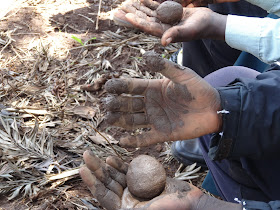By Sara:
There are so many acronyms for organization names! In order that you are not confused, let me explain: ADS is Anglican Development Services, the development organization of the Anglican Church, which World Renew works with here in Kenya. ADS Central Rift, to be specific, is the "branch" of ADS here in Nakuru that I work with. CFGB is the Canadian Foodgrains Bank, which is, among other things, currently funding a conservation agriculture project in Ethiopia, Kenya, and Tanzania.
Some of the staff from CFGB and World Renew came from Nairobi to join the ADS staff here in a soil testing training for farmers. Some of the lead farmers that ADS is working with gathered together; each one brought a small bag of the soil from their own farm to study and look at together.
They started out with seeing if the soil, when moist, had a nice smell (which is often indicative of healthy bacteria being present in the soil).
They looked at how the soil crumbled in their hands - if it was really hard or very powdery. They also got to see the pH of their soil - ADS borrowed a meter for checking soil pH. Interestingly, one farmer had a pH above 7 (which is a bit unusual for this area), while most of them had a pH between 5 and 6.5. I think the idea of testing the pH there was just to help the farmers think about how they can improve their soil through conservation agriculture, because they won't be able to test the pH on their own. However, in a couple years, ADS could borrow this tool again and let the farmers re-test to see if their soil pH has changed.
At the end, all of the farmers got to try to figure out what kind of soil they had by doing three things: forming it into a ball, trying to squeeze it into a ribbon, and feeling the texture rubbed between the thumb and forefinger. By putting together the results of those three simple tests, you can fairly accurately figure out if the soil is sandy loam, silty clay loam, silty clay, etc. There were different results among the various farmers, but pretty much everyone had a high clay content in their soil. Some people probably could have built clay pots (or ovens) with theirs! I thought that this was the best part of the training because it was something that people could practice at home, in their neighbor's field, or anywhere. They don't need any special tools and it is useful for understanding the makeup of their soil.




Interesting post!
ReplyDelete